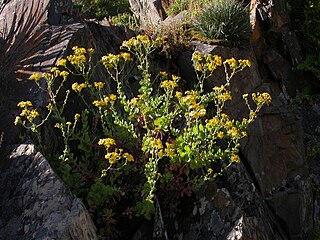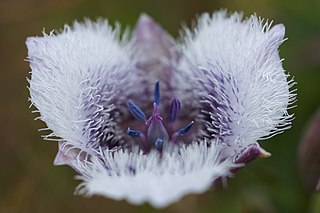Henry George Bohn was a British publisher. He is principally remembered for the Bohn's Libraries which he inaugurated. These were begun in 1846, targeted the mass market, and comprised editions of standard works and translations, dealing with history, science, classics, theology and archaeology.

Sir William Jackson Hooker was an English systematic botanist and organiser, and botanical illustrator. He held the post of Regius Professor of Botany at Glasgow University, and was Director of the Royal Botanic Gardens, Kew. He enjoyed the friendship and support of Sir Joseph Banks for his exploring, collecting and organising work. His son, Joseph Dalton Hooker, succeeded him to the Directorship of Kew Gardens.

Frederick William Beechey was an English naval officer and geographer.

Wiliwili, with the scientific name Erythrina sandwicensis, is a species of flowering tree in the pea family, Fabaceae that is endemic to the Hawaiian Islands. It is the only species of Erythrina that naturally occurs there. It is typically found in Hawaiian tropical dry forests on leeward island slopes up to an elevation of 600 m (2,000 ft).

George Arnott Walker-Arnott of Arlary FRSE was a Scottish botanist.
Anisopappus is a genus of flowering plants in the sunflower family.

Allium falcifolium is a North American species of wild onion known by the common name scytheleaf onion or coast flatstem onion. It is native to northern California and southern Oregon, where it grows in heavy, rocky soils, especially serpentine soils.

Amblyopappus is a genus in the daisy family described as a genus in 1841.

Grayia spinosa is a species of the genus Grayia of the subfamily Chenopodioideae in flowering plant family Amaranthaceae, which is known by the common names hop sage and spiny hop sage. It is widely distributed across the Western United States, where it grows in a number of desert and mountain habitats.

Senecio glabratus is a species of the genus Senecio and family Asteraceae.

Senecio nigrescens is a species of the genus Senecio and family Asteraceae and was first written about in the botanical classic Botany of Beechey's Voyage to the Pacific and Behring's Straits.

Calochortus tolmiei is a North American species of flowering plant in the lily family known by the common names Tolmie's star-tulip and pussy ears. It was discovered by and named for Dr. William Fraser Tolmie.

Calochortus uniflorus is a species of flowering plant in the lily family known by the common names Monterey mariposa lily and large-flowered star-tulip. It is native to western Oregon and to California as far south as San Luis Obispo County. It grows in moist areas, such as meadows, in coastal hills and lower-elevation mountains. Most of the populations are found in the Coast Ranges, but some occur in the Cascades and in the foothills of the Sierra Nevada.

Hyalis is a genus of South American flowering plants in the daisy family.
- Hyalis argenteaD.Don ex Hook. & Arn. - Bolivia
- Hyalis lancifoliaBaker - Bolivia, Argentina, Paraguay
Sinclairia is a genus of Latin American plants in the Liabeae tribe within the daisy family.
- Sinclairia adenotricha(Greenm.) Rydb. - Oaxaca
- Sinclairia andrieuxii(DC.) H.Rob. & Brettell - Oaxaca, Chiapas, Guatemala
- Sinclairia andromachioides(Less.) Sch.Bip. ex Rydb. - Veracruz
- Sinclairia angustissima(A.Gray) B.L.Turner - Jalisco
- Sinclairia broomaeH.Rob. - Guerrero
- Sinclairia caducifolia(B.L.Rob. & Bartlett) Rydb. - Guerrero
- Sinclairia cervina(B.L.Rob.) B.L.Turner - Jalisco
- Sinclairia deamii(B.L.Rob. & Bartlett) Rydb. - Tabasco, Chiapas, Yucatán Peninsula, Central America
- Sinclairia deppeana(Less.) Rydb. - Oaxaca
- Sinclairia dimidia(S.F.Blake) H.Rob. & Brettell - Chiapas, Guatemala
- Sinclairia discolorHook. & Arn. - from Panamá to Jalisco
- Sinclairia gentryi(H.Rob.) B.L.Turner - Nayarit
- Sinclairia glabra(Hemsl.) Rydb. - from Oaxaca to Nicaragua
- Sinclairia hintoniorumB.L.Turner - México State
- Sinclairia hypochlora(S.F.Blake) Rydb. - Chiapas, Guatemala
- Sinclairia ismaelisPanero & Villaseñor - Oaxaca
- Sinclairia klattii(B.L.Rob. & Greenm.) H.Rob. & Brettell - Oaxaca, Guerrero, Veracruz
- Sinclairia liebmannii(Klatt) Sch.Bip. ex Rydb. - Oaxaca
- Sinclairia manriqueiPanero & Villaseñor - Oaxaca
- Sinclairia moorei(H.Rob. & Brettell) H.Rob. & Brettell - Oaxaca
- Sinclairia palmeri(A.Gray) B.L.Turner - Durango
- Sinclairia platylepis(Sch.Bip. ex Sch.Bip.) Rydb.
- Sinclairia polyantha(Klatt) Rydb. - from Oaxaca to Colombia
- Sinclairia pringlei(B.L.Rob. & Greenm.) H.Rob. & Brettell - Jalisco, Nayarit
- Sinclairia sericolepis(Hemsl.) Rydb. - Chiapas, Oaxaca, Tabasco, Veracruz
- Sinclairia similis(McVaugh) H.Rob. & Brettell - Jalisco
- Sinclairia sublobata(B.L.Rob.) Rydb. - from Oaxaca to Nicaragua
- Sinclairia tajumulcensis(Standl. & Steyerm.) H.Rob. & Brettell - Guatemala
- Sinclairia vagans(S.F.Blake) H.Rob. & Brettell - Chiapas, Guatemala
Nardophyllum is a genus of South American flowering plants in the aster tribe within the sunflower family.

Anna Maria Walker and her husband Colonel George Warren Walker (1778–1843) were Scottish botanists in Ceylon who made extensive collections of plants between 1830 and 1838. Several species of ferns and orchids were named after them by Sir William Jackson Hooker with whom they corresponded. They also corresponded with and collaborated with other botanists in the region such as Robert Wight. Anna Maria was also an excellent botanical artist who illustrated many species of orchids. Plant species named after them include Vanilla walkeriae, Liparis walkeriae and Thrixspermum walkeri.

Bouvardia ternifolia, the firecracker bush, is a shrub widespread across much of Mexico, the range extending south into Honduras and north into the southwestern United States.
Berberis andrieuxii is a shrub in the Berberidaceae described as a species in 1838. It is endemic to the State of Oaxaca in southern Mexico.
Hymenoxys tweediei is a South American species of flowering plant in the daisy family. It has been found mostly in Uruguay with a few populations in northeastern Argentina and southern Brazil.
















